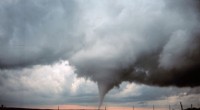
Wetenschap
A scientist compares the layers of sedimentary rock in a hillside and then applies principles relative dating What can conclude about hillside?
Principles of Relative Dating
* Superpositie: The oldest layers of sedimentary rock are at the bottom, and the youngest are at the top.
* Original Horizontality: Sedimentaire lagen worden oorspronkelijk horizontaal afgezet. If they are tilted or folded, it means something has happened since deposition.
* Lateral Continuity: Sedimentary layers extend laterally in all directions until they thin out or pinch out.
* Cross-Cutting Relationships: Any feature that cuts across a rock layer is younger than the layer it cuts.
* Inclusions: Fragments of one rock type found within another are older than the rock containing them.
Conclusions from Relative Dating
* Sequence of Events: The scientist can determine the order in which the sedimentary layers were deposited. This tells us the sequence of events in the hillside's history.
* Past Environments: Sedimentary rocks often tell us about the environment in which they were formed. For example, sandstone might indicate a desert, limestone might indicate a marine environment, and coal might indicate a swamp. By analyzing the types of sedimentary rocks and their sequence, the scientist can reconstruct the environmental history of the hillside.
* Geologic Processes: By looking at the relationships between layers, the scientist can identify geological processes that have acted upon the hillside.
* Folding and Tilting: Indicates compressional forces.
* fouten: Indicate displacement of the earth's crust.
* erosie: Indicates the removal of rock material.
* Relative Age of Features: De wetenschapper kan de leeftijd van verschillende kenmerken in de heuvel vergelijken, zoals fouten, indringers of erosieoppervlakken, om hun relatieve timing te begrijpen.
Limitations
* Absolute leeftijd: Relative dating only provides a sequence of events, not specific numerical ages. To get absolute ages, scientists use methods like radiometric dating.
* Incomplete Record: Erosie of andere processen kunnen delen van het sedimentaire record verwijderen, waardoor de reeks onvolledig is.
Samenvattend
Relatieve datering van sedimentaire rotsen is een krachtig hulpmiddel om de geologische geschiedenis van een heuvel te begrijpen. Het biedt een raamwerk voor het reconstrueren van vroegere omgevingen, het identificeren van geologische processen en het begrijpen van de relatieve timing van gebeurtenissen.
 Chemische reacties die betrokken zijn bij de groei van planten
Chemische reacties die betrokken zijn bij de groei van planten Wat zijn de typen kenmerken functies en structuren van een woestijn ecosysteem grasland aquatisch ecosysteem?
Wat zijn de typen kenmerken functies en structuren van een woestijn ecosysteem grasland aquatisch ecosysteem?  Engeland door droogte getroffen zomer 2022 gezamenlijk heetste ooit
Engeland door droogte getroffen zomer 2022 gezamenlijk heetste ooit Welke dieren eten teken van herten?
Welke dieren eten teken van herten?  Wat is het ontstaan van kleur?
Wat is het ontstaan van kleur?
Hoofdlijnen
- Wat schadelijk van bacteriën?
- Evalueer het belang van mutaties om biologische evolutie te verwerken?
- Computersimulatie verklaart waarom zebra's strepen hebben
- Hoe onderzoekers een decennia-oud mysterie met betrekking tot celvolume hebben opgelost
- Hoe heet het geslacht voor een kruidnagel?
- Wilt u kakkerlakkenseks verminderen? Blokkeer een enzym
- Wat vertegenwoordigt elk woord in termen van eiwitsynthese?
- De celstructuur van een ui
- Een cel besteedt ongeveer hoeveel van zijn cyclus in de M -fase?
 Interventie met een groeimindset vergroot het vertrouwen, doorzettingsvermogen bij studenten ondernemerschap
Interventie met een groeimindset vergroot het vertrouwen, doorzettingsvermogen bij studenten ondernemerschap Welke metalen zijn flexibel?
Welke metalen zijn flexibel?  Niet-lineaire geïntegreerde kwantum elektro-optische circuits
Niet-lineaire geïntegreerde kwantum elektro-optische circuits Wat zijn drie manieren waarop moleculen door een semipermeabiel membraan bewegen?
Wat zijn drie manieren waarop moleculen door een semipermeabiel membraan bewegen?  Blootstelling aan luchtvervuiling verschuift van buiten naar binnen - dit is waarom
Blootstelling aan luchtvervuiling verschuift van buiten naar binnen - dit is waarom Hoe maken sterren foto's?
Hoe maken sterren foto's?  De verschillen gladstrijken:supergeleiding in ultradun FeSe . begrijpen
De verschillen gladstrijken:supergeleiding in ultradun FeSe . begrijpen Maximale spectrale respons van germanium en silicium?
Maximale spectrale respons van germanium en silicium?
- Elektronica
- Biologie
- Zonsverduistering
- Wiskunde
- French | Italian | Spanish | Portuguese | Swedish | German | Dutch | Danish | Norway |

-
Wetenschap © https://nl.scienceaq.com






